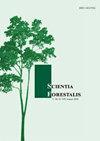木棉(锦葵科)是一种需要光的物种,在深阴影下会屈服吗?
IF 0.4
4区 农林科学
Q4 FORESTRY
引用次数: 1
摘要
本文章由计算机程序翻译,如有差异,请以英文原文为准。
Does Ceiba pentandra (Malvaceae) a light demanding species succumb under deep shading?
Sumauma ( Ceiba pentandra ) is a fast-growing and light-demanding species that occurs across a wide rainfall range in tropical regions, but it is still unclear how it performs under shading. This work aimed to evaluate leaf traits and biomass allocation of sumauma seedlings in response to different levels of artificial shadings. After a strengthening period of 14 months (at moderate light), the seedlings were submitted to three shading levels for 580 days: moderate shading (T 1 : irradiance of 5.59 mol m ‒ 2 day ‒ 1 ), strong shading (T 2 : 1.29 mol m ‒ 2 day ‒ 1 ), and deep shading (T 3 : 0.14 mol m ‒ 2 day ‒ 1 ). The control (T 0 ) was seedlings under direct sunlight (15.65 mol m –2 day –1 ). Parameters evaluated were plant growth, biomass allocation to plant organs and leaf traits. Growth and biomass accumulation enhanced with a rise in irradiance, being maximum under direct sunlight and null under deep shading. Sumauma did not succumb under deep shading, as it was able to endure deep shading for 19 months. Under deep shading, the seedlings allocated just a little amount of biomass to leaves and greatly reduced leaf thickness. The whole-plant compensation point was estimated to be 1.0 mol m ‒ 2 day ‒ 1 . We concluded that pre-strengthened sumauma seedlings may endure deep shading. These traits combined with the high growth rates of this tree under full sunlight make of sumauma a promising candidate to be tested in reforestation projects.
求助全文
通过发布文献求助,成功后即可免费获取论文全文。
去求助
来源期刊

Scientia Forestalis
Agricultural and Biological Sciences-Forestry
CiteScore
1.00
自引率
0.00%
发文量
39
期刊介绍:
Scientia Forestalis is a scientific publication of the IPEF – Institute of Forest Research and Studies, founded in 1968, as a nonprofit institution, in agreement with the LCF – Department of Forest Sciences of the ESALQ – Luiz de Queiroz College of Agriculture of the USP – São Paulo University. Scientia Forestalis, affiliated to the ABEC – Brazilian Association of Scientific Publishers, publishes four issues per year of original papers related to the several fields of the Forest Sciences.
The Editorial Board is composed by the Editor, the Scientific Editors (evaluating the manuscript), and the Associated Editors (helping on the decision of acceptation or not of the manuscript, analyzed by the Peer-Reviewers.
 求助内容:
求助内容: 应助结果提醒方式:
应助结果提醒方式:


